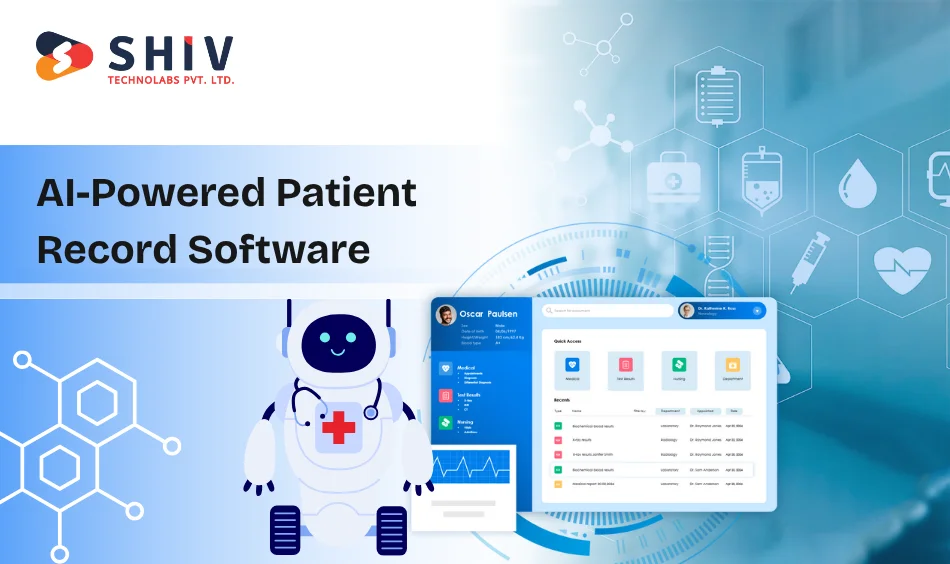Table of Contents
Keeping track of patient records shouldn’t feel like juggling papers, scrolling through emails, or digging through old folders. But for many clinics, that’s still the daily routine. Important details fall through the cracks, and time gets wasted looking for things that should be one click away.
Patient record management software changes that.
It puts everything in one place: medical history, test results, prescriptions, and doctor notes.
No clutter. No delays. Just clean, organized records your team can trust. Whether you’re a solo doctor or managing a full hospital, it helps you stay on top of care without losing time or accuracy.
And it’s not just about convenience. It’s about better care, fewer mistakes, and a clinic that runs smoothly without the stress.
In this guide, you’ll see how the software works, what it costs, and which features matter.
Let’s get started.
What Is PRMS and How Does It Work?
Patient record management software is a digital tool that helps clinics and hospitals keep track of everything about a patient’s care. Instead of storing details in paper files or across scattered apps, this software brings all that information into one system.
Think of it like a digital file cabinet, but smarter.
You can store and access medical history, prescriptions, test results, doctor notes, and even billing details — all from a single dashboard. Everything is searchable, secure, and easy to update.
Here’s what it typically helps manage:
- Patient profiles with contact info, ID, insurance, and allergies
- Visit records with symptoms, diagnoses, and treatments
- Lab and scan results, attached directly to the patient’s file
- Prescription history, including past medications and dosage
- Doctor and nurse notes, added after each visit
- Invoices and payment details, linked to each patient
Whether you run a single clinic or a multi-location hospital, this kind of software gives your staff one reliable place to enter, find, and update patient information.
The result? Less confusion, fewer errors, and faster care.
What to Include in Your PRMS – Let’s Talk Features

Not all software is built the same. If you’re thinking about getting a patient record system, here are the features that actually matter. These help your clinic run smoother and make life easier for everyone involved — from front-desk staff to doctors.
1. Electronic Health Records (EHR) Integration
The software should connect easily with EHR systems so patient info flows in without extra typing. It keeps data consistent and avoids mistakes.
2. User Roles and Access Control
Different staff members need different levels of access. Receptionists shouldn’t edit lab reports, and nurses shouldn’t see billing unless needed. Good software lets you set roles with clear permissions.
3. Appointment and Visit Tracking
Each patient visit should be recorded with date, time, reason, and doctor’s notes. This builds a clear timeline of care.
4. Lab Reports and Imaging Storage
Attach test results, scans, and x-rays directly to the patient file. This helps doctors make faster, better decisions without chasing files.
5. Doctor and Nurse Notes
Every update, from a routine checkup to an emergency visit, should be logged clearly. Notes help other care providers understand what’s been done and what comes next.
6. Audit Logs and History Tracking
A good system tracks who made changes and when. If something goes wrong, you’ll know what happened and can fix it quickly.
7. ePrescriptions and Billing Integration
Send prescriptions directly to pharmacies and generate bills right after a visit. This saves time and avoids double entry.
8. Mobile Access for On-the-Go Use
Doctors often move between rooms or even buildings. Mobile access means they can check records or update notes from a phone or tablet.
9. HIPAA or GDPR Compliance Tools
Privacy matters. Your software must support compliance with local regulations so patient data stays safe and legally protected.
Patient Record Management Software Development – Step-by-Step Process
You don’t need to be tech-savvy to use this software. It fits right into the daily routine of any clinic or hospital. Here’s how it usually works from the moment a patient walks in to the time they leave.
Step 1: Patient Visit and Data Entry
The front desk creates a new patient profile or pulls up an existing one. They check contact info, ID, insurance, and any known allergies or health issues.
Step 2: Doctor Access and Medical Review
The doctor sees everything in one place — previous visits, lab results, prescriptions, and ongoing conditions. This helps them get a full picture before speaking with the patient.
Step 3: Lab Results, Imaging, and Reports
If the patient needs tests, the results can be added directly to their file. No need to fax or email anything. Everything stays tied to their profile.
Step 4: Prescription, Billing, and Follow-up
Once the visit is done, the doctor can write ePrescriptions, the billing team can raise an invoice, and the system can set reminders for future visits or tests.
Step 5: Ongoing Access and Record Updates
The patient’s record keeps growing with each visit. Any doctor or nurse involved can check past notes, update treatments, or flag important alerts in real time.
The goal is simple: less paperwork, more time for patients, and nothing important gets missed.
AI-Powered Patient Record Software – Some Facts and Stats

AI isn’t just hype in healthcare software development services. It helps catch errors, speed up work, and improve care.
- Flag dangerous mistakes: AI can alert staff if a patient is prescribed something they’re allergic to. A study in JAMA found that AI-supported systems reduce prescription errors by up to 50%.
- Faster, smarter search: Instead of typing exact terms, AI lets doctors search records by meaning, like “patients with low iron over time,” and finds it fast.
- Predicts health risks early: IBM research shows AI can detect early signs of chronic diseases like diabetes months before symptoms appear, by spotting patterns in test results.
For busy clinics, it’s not about replacing anyone. It’s about saving hours, catching issues early, and helping people make better calls under pressure.
Benefits of PRMS – For Admin, Doctors and Patients
The right software doesn’t just store information — it helps people do their jobs better. Here’s how it helps across different roles in a clinic or hospital:
1. For Hospital Admins
- Centralized records reduce paperwork and manual tracking
- Access control ensures that only the right staff can see or edit sensitive data
- Audit trails make it easy to track changes for compliance and reporting
- Fewer billing mistakes by linking records with payment details
- Faster onboarding for new staff with clear workflows and permissions
2. For Doctors and Nurses
- Quick access to full patient history, including notes, labs, and prescriptions
- Less time spent on manual data entry, thanks to smart templates or AI suggestions
- More accurate decisions with real-time updates from the lab and pharmacy
- Shared access across departments improves collaboration
- No more paper folders or waiting on another department for patient info
3. For Patients
- Shorter wait times at check-in, labs, or follow-ups
- No need to repeat information every visit — history is already there
- More accurate care since nothing gets missed or misread
- Easier access to prescriptions, reports, and billing via patient portals
- Better communication with care teams, especially for chronic conditions
From daily operations to long-term care quality, a good patient record system makes things smoother for everyone involved.
How Much Does it Cost to Develop a PRMS?
There’s no one-size-fits-all price tag here. The cost depends on how complex your needs are, how many people will use the system, and whether you choose something off the shelf or want it built just for you.
Below are a few realistic case scenarios to give you a better idea:
Scenario 1: Small Clinic with 3–5 Users
| Feature | Cost (Approx.) |
|---|---|
| Monthly SaaS Subscription | $100 to $250/month |
| Setup & Training Fee | $500 to $1,000 (one-time) |
| Optional Add-ons (e.g., SMS Reminders) | $20 to $50/month |
This is best for solo doctors or small practices that want a simple, ready-made solution with basic features.
Scenario 2: Mid-size Clinic or Multi-Specialty Practice
| Feature | Cost (Approx.) |
|---|---|
| Monthly SaaS Subscription | $400 to $800/month |
| Custom Setup & Migration | $2,000 to $5,000 |
| Mobile Access or API Add-ons | $500 to $1,500 (one-time) |
Good for clinics with multiple doctors, departments, or integration needs (like lab tools or pharmacy systems).
Scenario 3: Custom Software for a Hospital or Chain
| Feature | Cost (Approx.) |
|---|---|
| Full Custom Development | $15,000 to $50,000 |
| Integration with Existing Systems | $5,000 to $20,000 |
| Annual Support & Maintenance | $2,000 to $10,000/year |
This works for hospitals, large clinics, or health chains looking for a fully tailored solution with complete data control.
# So what’s the overall range?
If you go with an off-the-shelf system, you might spend as little as $1,500 to $5,000 per year.
For custom software development, expect to invest anywhere from $15,000 to $70,000 or more, depending on your needs.
The right choice depends on how much flexibility you need, how many people will use it, and whether you plan to grow.
Why Choose Shiv Technolabs for Patient Record Software Development
If you’re planning to build a patient record system that works for your team, not against it, we’re here to help.
At Shiv Technolabs, we build custom healthcare software that fits how real clinics operate. Whether you’re a solo doctor, a multi-specialty clinic, or a hospital network, we help you design tools that feel natural to use from day one.
Here’s what we offer:
- Custom-built software that fits your workflow
- Mobile and tablet support so your team can work anywhere
- Role-based access control and built-in compliance features
- Integration support for labs, pharmacy tools, or third-party systems
- Smart AI features like record suggestions, alerts, and data validation
- Clear documentation and real support — no chatbots or ticket loops
If you’re tired of clunky tools that slow you down, we’ll help you build one that works better — because it’s built for you.
Let’s build something that helps your team focus on care, not clicks.
Build What Your Clinic Needs
Patient care is complicated. Your software shouldn’t be.
Whether you’re running a small clinic or managing a growing hospital, having the right patient record system makes everything easier, from the front desk to the exam room. It keeps records clean, cuts down errors, saves time, and helps everyone focus on what matters: the patient.
Don’t wait for paperwork problems or missed follow-ups to slow you down. If your current system feels like a patchwork of tools that don’t talk to each other, it’s time to change that.
Shiv Technolabs builds custom solutions that fit your daily routine. No clutter. No shortcuts. Just software that works the way your team already does — only faster, safer,
and better.
Ready to build something smarter? Let’s talk.






















